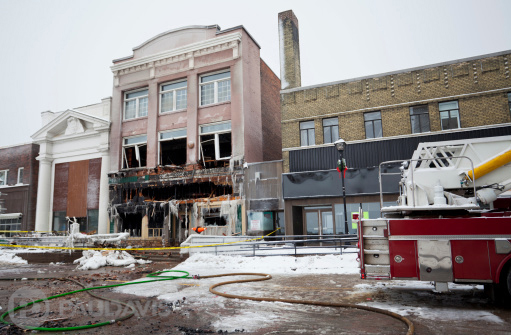
Coffee makers, toaster ovens and microwaves are responsible for more than delicious beverages, quick snacks and hot meals. They’re frequently to blame when retail establishments catch fire. And they do erupt in flames with unsettling regularity. Emergency personnel respond to thousands of retail conflagrations yearly that together ring up millions in property losses. Appliances aren’t completely to blame, of course: electrical malfunctions, employee misconduct and arson round out the list of culprits. Sadly, retail locations are particularly attractive targets for arson.
If you experience a retail fire, it’s important to take right steps immediately after the flames are quenched. You’ll be back to business sooner with a five-step approach: Step Away, Reach Out, Stay Secure, List Losses and Launch Recovery.
Step Away: As tempting as it is to step carefully and pick gingerly through burned items, resist the urge and prevent others from entering the premises. Fueled by modern manufactured materials, today’s fires reach hotter temperatures and the resulting smoke and soot is toxic. Burn residue from natural materials like wood and cotton are unhealthy, but the plastics, nylons, polyurethanes and computer materials found in retail today can harm human health far more seriously.
Reach Out: Notify all important stakeholders immediately. Contact insurance providers, landlords, lending institutions, debtors, employees, suppliers, customers and parent company if applicable. Ensure that all receive necessary information and documentation, whether they are cancelling shipments, processing insurance claims or planning a shopping trip. These notifications service a dual purpose: they bring aid and control people-distractions from the recovery process.
Stay Secure: Secure the property immediately no matter what time the fire occurs, hiring security personnel if necessary to avoid safety risks and looting. If computer files or other sensitive information are at risk, consider retaining firms that specialize in digital recovery and restoration. Experienced disaster recovery experts like Paul Davis who rapidly respond 24/7 can help manage security processes.
List Losses: Prepare to document losses with photos, descriptions, inventory lists and any supporting paperwork. Insurance agents, suppliers and lending institutions require these items to begin the recovery, restoration and, eventually, restocking process.
Launch Recovery: An experienced restoration company like Paul Davis will begin cleanup and restoration while attending to the unique needs of retail properties. These professionals rapidly secure the damaged property, assess damages, salvage inventory, control risks from soot and smoke and implement specific cleanup processes. The goal: restoring the site as quickly as possible to maintain revenue flow and customer base.
Finally, as business returns to normal and customers visit a fully recovered space, prepare a comprehensive fire safety and mitigation plan. Prevention is the best safeguard against fiery business disruptions.
